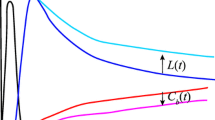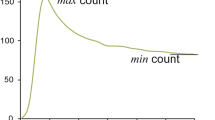Abstract
Objective
In clinical practice, measurement of the rCBF has mainly been conducted by I-123-N-isopropyl-p-iodoamphetamine (123I-IMP) SPECT using the microsphere (MS) method, with continuous arterial blood sampling. While several non-invasive 123I-IMP quantification methods have been developed, their accuracy has been shown to be lower than that of the MS method. Therefore, a non-invasive quantification method for use in routine clinical practice is being sought. The purpose of this study was to develop a simple non-invasive 123I-IMP quantification method (SIMS method) with a simple input function-determining protocol based on the MS method.
Method
The input function for the SIMS method was determined using the administered dose and the integrated lung washout ratio obtained by analyzing the count–time activity curve of the pulmonary artery and lung on dynamic chest images. The mean CBF (mCBF) and input function measured in 80 patients by the SIMS method was compared with those determined using the MS method.
Result
A good correlation was observed between the counts measured by continuous arterial blood sampling in the MS method and the estimated counts by image analysis in the new method (r = 0.94, p < 0.01). Similarly, a good correlation was observed between the mCBF values determined by the MS method and the SIMS method (r = 0.83, p < 0.01).
Conclusion
The mCBF values determined by the SIMS method were closely consistent with the values obtained by the MS method. This finding indicates the possibility of use of the SIMS method for routine clinical study.






Similar content being viewed by others
References
Inui Y, Toyama H, Manabe Y, Sato T, Sarai M, Kosaka K, et al. Evaluation of probable or possible dementia with Lewy bodies using 123I-IMP brain perfusion SPECT, 123I-MIBG, and 99mTc-MIBImyocardial SPECT. J Nucl Med. 2007;48(10):1641–50.
Kanai Y, Hasegawa S, Kimura Y, Oku N, Ito H, Fukuda H, et al. N-isopropyl-4-[123I]iodoamphetamine (123I-IMP) products: a difference in radiochemical purity, unmetabolized fraction, and octanol extraction fraction in arterial blood and regional brain uptake in rats. Ann Nucl Med. 2007;21:387–91.
Matsuda H, Oba H, Terada H, Tsuji S, Sumiya H, Shiba K, et al. Quantitative assessment of cerebral blood flow using technetium-99m-hexamethyl-propyleneamine oxime: part I, design of a mathematical model. Ann Nucl Med. 1988;2:13–9.
Wong CH, Mohamed A, Larcos G, McCredie R, Somerville E, Bleasel A. Brain activation patterns of versive, hypermotor, and bilateral asymmetric tonic seizures. Epilepsia. 2010;51(10):2131–9.
Odano I, Ohkubo M, Yokoi T. Noninvasive quantification of cerebral blood flow using 99mTc-ECD and SPECT. J Nucl Med. 1999;40:1737–44.
Van Laere K, Dumont F, Koole M, Dierckx R. Non-invasive methods for absolute cerebral blood flow measurement using 99mTc-ECD: a study in healthy volunteers. Eur J Nucl Med. 2001;28:862–72.
Newberg AB, Wintering N, Khalsa DS, Roggenkamp H, Waldman MR. Meditation effects on cognitive function and cerebral blood flow in subjects with memory loss: a preliminary study. J Alzheimers Dis. 2010;20(2):517–26.
Kuhl DE, Barrio JR, Huang SC, Selin C, Ackermann RF, Lear JL, et al. Quantifying local cerebral blood flow by N-isopropyl-p-(123I)iodoamphetamine (IMP) tomography. J Nucl Med. 1982;23:196–203.
Lassen NA, Henriksen L, Holm S, Barry DI, Paulson OB, Vorstrup S, et al. Cerebral blood-flow tomography:xenon-133 compared with isopropyl-amphetamine-iodine-123: concise communication. J Nucl Med. 1983;24:17–21.
Matsuda H, Seki H, Sumiya H, Tsuji S, Tonami N, Hisada K, et al. Quantitative cerebral blood flow measurements using N-isopropyl-(iodine 123) p-iodoamphetamine and single photon emission computed tomography with rotating gamma camera. Am J Physiol Imaging. 1986;1(4):186–94.
Yokoi T, Iida H, Itoh H, Kanno I. A new graphic plot analysis for cerebral blood flow and partition coefficient with iodine-123-iodoamphetamine and dynamic SPECT validation studies using oxygen-15-water and PET. J Nucl Med. 1993;34(3):498–505.
Iida H, Itoh H, Nakazawa M, Hatazawa J, Nishimura H, Onishi Y, et al. Quantitative mapping of regional cerebral blood flow using iodine-123-IMP and SPECT. J Nucl Med. 1994;35:2019–30.
Iida H, Itoh H, Bloomfield P, Munaka M, Higano S, Murakami M, et al. A method to quantitate cerebral blood flow using a rotating gamma camera and iodine-123 iodoamphetamine with one blood sampling. Eur J Nucl Med. 1994;21:1072–84.
Ito S, Tkaki A, Inoue S, Tomiguchi S, Shiraisgi S, Akiyama Y, et al. Improvement of the 99mTc-ECD brain uptake ratio (BUR) method for measurement of cerebral blood flow. Ann Nucl Med. 2012;26(4):351–8.
Tomiguchi S, Tashiro K, Shiraishi S, Yoshida M, Kawanaka K, Takahashi Y, et al. Estimation of 123I-IMP arterial blood activity from dynamic planar imaging of the chest using a graph plot method for the quantification of regional cerebral blood flow. Ann Nucl Med. 2010;24(5):387–93.
Abe S, Kato K, Takahashi Y, Fujita N, Yamashita M, Shinoda M, et al. Estimation of 123I-IMP arterial blood activity using 123I-IMP acquisition data from the lungs and brain without any blood sampling: validation of its usefulness for quantification of regional cerebral blood flow. Clin Nucl Med. 2012;37:258–63.
Yonekura Y, Sugihara H, Taniguchi Y, Aoki E, Furuichi K, Miyazaki Y. Quantification of brain perfusion SPECT with N-isopropyl-p-iodoamphetamine using noninvasive microsphere method: estimation of arterial input by dynamic imaging. Kaku Igaku. 1997;34:901–8.
Yonekura Y, Fujita T, Nishizawa S, Iwasaki Y, Mukai T, Konishi J. Temporal changes in accumulation of N-isopropyl-p-iodoamphetamine in human brain: relation to lung clearance. J Nucl Med. 1989;30:1977–81.
Takeuchi R, Yonekura Y, Matsuda H, Konishi J. Usefulness of a three-dimensional stereotaxic ROI template on anatomically standardised 99mTc-ECD SPET. Eur J Nucl Med Mol Imaging. 2002;29:331–41.
Nishizawa S, Shimozaki T, Ueno M, et al. A new method to estimate rCBF using IMP and SPECT without any blood sampling. Ann Nucl Med. 2000;14:433–40.
Kanno I, Iida H, Miura S, Murakami M, Takahashi K, Sasaki H, et al. A system for cerebral blood flow measurement using an H2O-15 autoradiographic method and positron emission tomography. J Cereb Blood Flow Metab. 1987;7:143–53.
Iida H, Kanno I, Miura S, Murakami M, Takahashi K, Uemura K. Error analysis of a quantitative cerebral blood flow measurement using H2O-15 autoradiography and positron emission tomography: with respect to the dispersion of the input function. J Cereb Blood Flow Metab. 1986;6:536–45.
Iida H, Akutsu T, Endo K, Fukuda H, Inoue T, Ito H, et al. A multicenter validation of regional cerebral blood flow quantitation using [123I]iodo-amphetamine and single photon emission computed tomography. J Cereb Blood Flow Metab. 1996;16:781–93.
Shimosegawa E, Fujino K, Kato H, Hatazawa J. Quantitative CBF measurement using an integrated SPECT/CT system: validation of three-dimensional ordered-subset expectation maximization and CT-based attenuation correction by comparing with O-15 water PET. Ann Nucl Med. 2013;27:822–33.
Iida H, Akutsu T, Endo K, et al. Multicenter validation of regional cerebral blood flow quantification using I-123 iodoamphetamine and single photon emission computed tomography. J Cereb Blood Flow Metab. 1996;16:781–93.
Author information
Authors and Affiliations
Corresponding author
Ethics declarations
Conflict of interest
None.
Rights and permissions
About this article
Cite this article
Ofuji, A., Mimura, H., Yamashita, K. et al. Development of a simple non-invasive microsphere quantification method for cerebral blood flow using I-123-IMP. Ann Nucl Med 30, 242–249 (2016). https://doi.org/10.1007/s12149-015-1053-8
Received:
Accepted:
Published:
Issue Date:
DOI: https://doi.org/10.1007/s12149-015-1053-8




